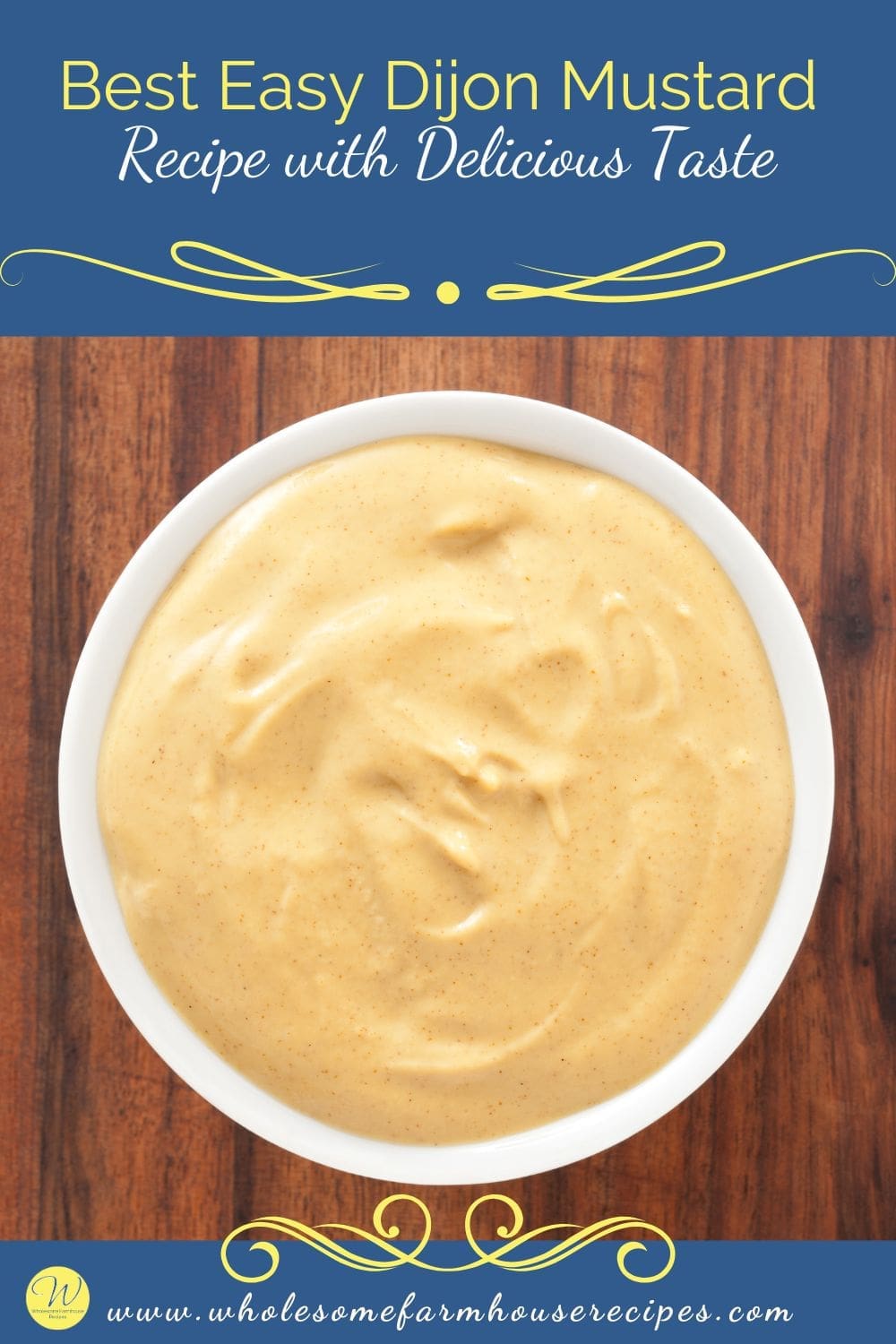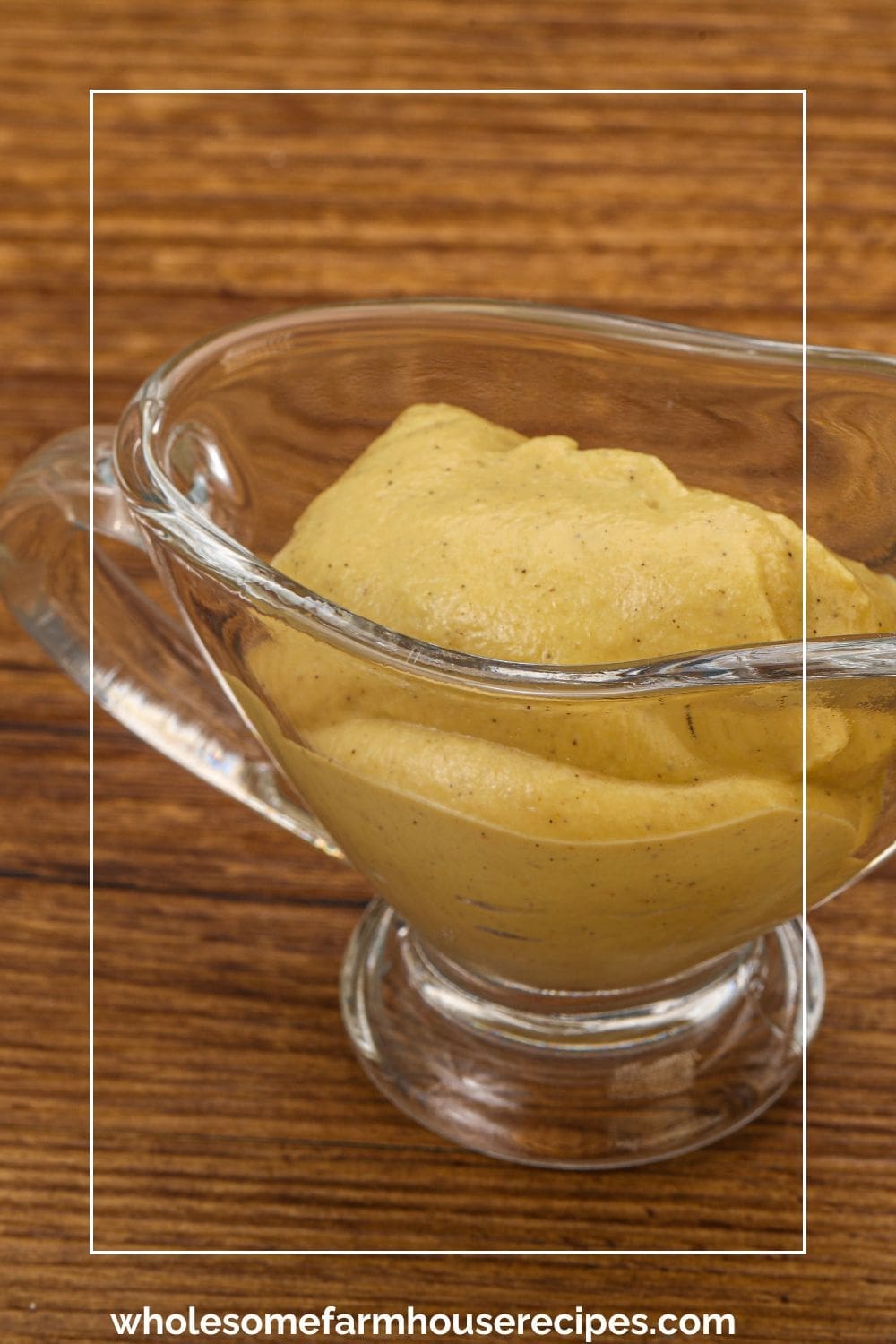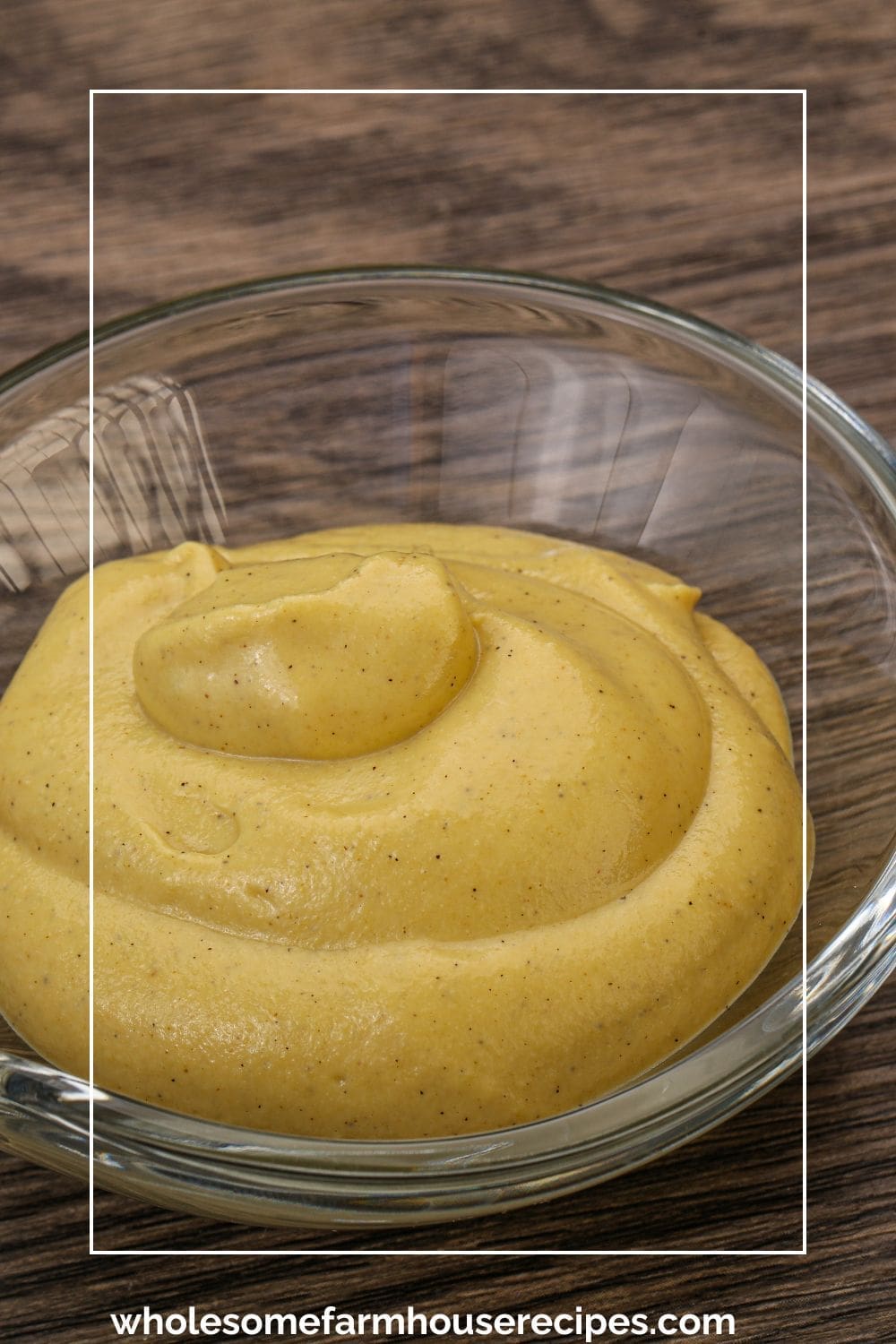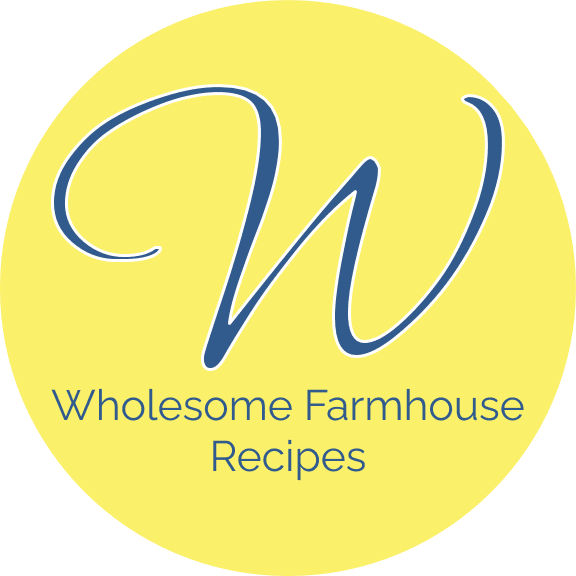Last updated on March 30th, 2025 at 07:50 pm
If you’re a mustard aficionado like me, you know that nothing beats the tangy kick of a good Dijon mustard recipe. Whether you’re dressing up a hot dog, adding depth to a salad dressing, or enhancing the flavors of a potato salad. Homemade Dijon mustard elevates every dish with its smooth texture and irresistible flavor.
We are a family that loves our mustard in potato salad, on our hot dogs, as a base for dipping sauce, in our garlic butter mustard sauce, and many other uses. It is easy and fun to make your own mustard sauce.

Why Make Your Own Homemade Dijon Mustard?
Making your own Dijon mustard at home allows you to control the ingredients and customize it to suit your taste buds. Forget the generic brands; with simple ingredients like whole mustard seeds, white wine, and a hint of honey, you can create a superior product that surpasses anything you’ll find in the condiment aisle.
Best Easy Dijon Mustard Recipe with Delicious Taste
As an Amazon Associate I earn from qualifying purchases.
Kitchen Essentials
Ingredients
- 1/4 Cup Brown Mustard Seeds
- 1/4 Cup Yellow Mustard Seeds
- 1/2 Cup White Wine or white wine vinegar for a non-alcoholic option
- 1/4 Cup Apple Cider Vinegar
- 2 Tablespoons Water
- 1 Tablespoon Honey optional for a touch of sweetness
- 1/2 Teaspoon Salt
- 1/8 Teaspoon Cayenne Pepper optional for a slight kick
Instructions
- Soak the Mustard Seeds. In a small bowl, combine the brown mustard seeds, yellow mustard seeds, and white wine. Cover and let the seeds soak for 24 hours at room temperature. This step softens the seeds and helps release their natural flavors.1/4 Cup Brown Mustard Seeds, 1/4 Cup Yellow Mustard Seeds, 1/2 Cup White Wine
- Blend the Mustard. After 24 hours, transfer the soaked seeds (along with the soaking liquid) into a blender or food processor. Add the apple cider vinegar, water, salt, honey (if using), and cayenne pepper (if using). Blend until smooth. If you prefer a slightly chunkier texture, pulse the mixture a bit less.1/4 Cup Apple Cider Vinegar, 2 Tablespoons Water, 1 Tablespoon Honey, 1/2 Teaspoon Salt, 1/8 Teaspoon Cayenne Pepper
- Taste and Adjust. Taste your mustard and adjust the flavor as needed. Add more honey for sweetness, vinegar for tang, or cayenne for extra heat. Blend to combine any adjustments.
- Adjust Consistency. Check the mustard’s consistency. If it’s too thick for your liking, add a little more water to reach your desired texture. Blend again if necessary.
- Cook the Mustard. Pour the blended mixture into a small saucepan over medium-low heat. Cook, stirring frequently, for 5-10 minutes until the mustard thickens. The heat will mellow the strong bite of the mustard and bring out a more balanced, tangy flavor.
- Cool and Store. Once thickened, remove from heat and let the mustard cool completely. Transfer to a sterilized glass jar and let it rest for at least 24 hours before using to allow the flavors to fully develop.
Your Own Private Notes
Notes
Let it Rest
Transfer the mustard into a clean jar or airtight container. Let it sit at room temperature for 2-3 days to allow the flavors to meld and deepen. Dijon mustard will continue to develop its flavor the longer it rests.Storage of Homemade Dijon Mustard After resting, store your homemade Dijon mustard in the refrigerator. It will last for up to 1 month.
Recipe Tips
• Wine Substitution. If you don’t have white wine on hand, you can use white wine vinegar for a tangier mustard.• Spiciness. Dijon mustard can vary in spiciness. If you like a milder mustard, use more yellow mustard seeds and less brown mustard seeds. For a stronger flavor, increase the amount of brown mustard seeds.
• Texture. For a smoother mustard, blend longer. If you prefer more texture, pulse less.
Nutrition
What to Use Homemade Dijon Mustard For?
- Perfect for adding a sharp flavor to salad dressings, sandwiches, and marinades.
- Great for potato salad or egg salad.
- Add it to grilled meats, sausages, and hot dogs.
- Use as a dip for pretzels or mix into sauces for extra flavor.
Enjoy your homemade Dijon mustard, packed with flavor and a touch of sophistication.

Why Homemade Dijon Mustard?
Homemade Dijon mustard not only tastes better than store-bought varieties but also gives you the satisfaction of creating something special in your own kitchen. Plus, you can experiment with different flavors like adding balsamic vinegar for a unique twist or using whole grain mustard for added texture.
Where to Find Ingredients?
You can easily find whole mustard seeds, white wine, and honey at your local grocery store or specialty food shops. Experiment with different brands and types of mustard seeds to find what suits your palate best.
Why Cook Dijon Mustard?
- Cooking smooths out the sharpness of raw mustard.
- It helps the flavors blend and deepen over time.
- The heat activates the mustard’s natural enzymes, making it taste more like traditional Dijon mustard you’d find in stores like Grey Poupon, Edmond Fallot, or Primal Kitchen.
Make This a Creamy Dijon Mustard
Traditional Dijon mustard is made from just mustard seeds, vinegar, wine (or wine vinegar), and a few seasonings, without any mayonnaise or creamy ingredients. The smooth texture and tangy flavor come from the ingredients listed above, with wine or vinegar providing the acidity and the mustard seeds offering the spice and depth.
However, some creamy Dijon-style mustards or mustard-based sauces may contain mayo, cream, or egg yolks to create a smoother, richer, and creamier consistency. This version is often used in mustard-based dressings, sandwich spreads, or condiments where a creamier texture is desired.
If you’re looking for a creamier Dijon mustard or a Dijon mustard dressing that includes mayo, you can easily modify the basic recipe by adding mayonnaise or Greek yogurt for a creamy consistency.
Here’s how you could adapt the homemade recipe for a creamy version.
- Extra Smooth & Creamy. Blend in 1/4 cup mayonnaise (or Greek yogurt for a tangier version and 1-2 tablespoons of heavy cream or sour cream for an ultra-smooth, luxurious texture.
Recipe Variations
- Honey Mustard. Add extra honey. Stir in 1-2 tablespoons of honey for a sweet, balanced mustard that pairs well with chicken, pretzels, or salad dressings.
- Spicy Dijon Mustard. Increase the cayenne pepper to 1/2 teaspoonor add a few dashes of hot sauce to give it a bold kick.
- Garlic & Herb Dijon. Mix in 1 teaspoon of minced garlic and 1 teaspoon of dried herbs (like thyme or tarragon) for a gourmet twist.
- Balsamic Dijon Mustard. Replace half of the white wine vinegar with balsamic vinegar for a deeper, slightly sweet tang.
- Whole Grain Creamy Dijon. Stir in 1 tablespoon of whole mustard seeds after blending for a grainy texture with little bursts of spice.
Whole Grain Mustard vs Dijon
Whole Grain Mustard
Texture & Appearance
Whole grain mustard, also known as “grainy mustard”, contains visible mustard seeds suspended in a thick, coarse mustard paste. The seeds are often left partially crushed, creating a more textured and less smooth consistency compared to Dijon mustard.
Flavor
The flavor of whole grain mustard is generally spicier and more robust because of the whole seeds. The mustard seeds retain their bite, giving it a more noticeable crunch and a bit of heat. It tends to be milder in acidity compared to Dijon, offering a stronger, earthier flavor profile with a slightly tangy kick.
Uses
Whole grain mustard is a great addition to salad dressings, sandwiches, and charcuterie boards. It’s also commonly used in marinades or barbecue sauces and pairs wonderfully with meats like sausages, roast chicken, and beef. Its texture also makes it ideal for dipping, especially with pretzels or as an accompaniment to cheeses.
Dijon Mustard
Texture & Appearance
Dijon mustard is smooth and creamy, with no visible seeds. It’s typically finely ground, creating a uniform consistency. The color ranges from pale yellow to light brown, depending on the specific ingredients and mustard seeds used.
Flavor
Dijon mustard has a milder, smoother flavor profile compared to whole grain mustard. It’s less spicy and features a more sharp tang with a slight vinegar or wine undertone. The smooth texture allows for easy incorporation into dishes without overpowering other flavors.
Uses
Dijon mustard is versatile and used in a variety of applications such as salad dressings, marinades, sandwich spreads, or as a dipping sauce. It’s also an essential ingredient in French vinaigrettes and potato salads. Dijon’s smooth texture makes it perfect for dishes where you don’t want the crunch of seeds but still want the bold flavor of mustard.
Key Differences
- Texture. Whole grain mustard has a coarse, seed-filled texture, while Dijon is smooth and creamy.
- Flavor. Whole grain mustard is spicier with a bolder, earthier flavor and crunch, while Dijon is milder, sharper, and creamier.
- Uses. Whole grain mustard is great for adding texture and heat to recipes, while Dijon is often used for smooth spreads and dressings.
Which One to Choose?
If you love a spicy mustard with a crunchy texture, whole grain mustard is the way to go. If you’re after a smooth, tangy mustard for sauces, dressings, or a more subtle flavor, Dijon is your best bet.
Both mustards are great options depending on the flavor profile you’re aiming for in your dish.

Mustard vs Dijon Mustard
The difference between mustard and Dijon mustard mainly lies in their ingredients, flavor, and origin. Here’s a breakdown of how the two differ:
Ingredients
Mustard (often referred to as yellow mustard in the U.S.) is typically made from a blend of ground yellow or white mustard seeds, vinegar, water, salt, and a small amount of sugar. It often contains turmeric, which gives it a vibrant yellow color and a mild, slightly sweet flavor.
Dijon Mustard, on the other hand, is made from brown or black mustard seeds (which are spicier than yellow seeds) and typically includes white wine or wine vinegar in its preparation, which gives it a sharper, tangier, and more sophisticated flavor. It’s often smoother and lacks the bright yellow hue because it doesn’t include turmeric.
Flavor
Mustard (yellow mustard) tends to be milder, sweeter, and less spicy compared to Dijon. The use of turmeric gives it a distinct, somewhat earthy flavor with a slightly sweet finish. Often associated with American-style mustard, especially popular for use on hot dogs, burgers, and in classic potato salads.
Dijon mustard originates from Dijon, France, and it’s a staple in French cuisine. It has a spicier and tangier flavor with a more refined and complex taste profile. The wine vinegar or white wine gives Dijon a more sharp and zesty flavor compared to the milder, sweeter taste of yellow mustard. Commonly used in French vinaigrettes, sandwiches, and marinades due to its smooth texture and sharp taste. It’s also a popular choice for mustard-based vinaigrettes and creamy mustard sauces.
In Summary
Mustard (yellow mustard) is milder, sweeter, and more commonly associated with American cuisine, often seen on hot dogs and burgers. It tends to have a smoother texture, and in some cases, a slightly runny consistency.
Dijon mustard is sharper, spicier, and has a more sophisticated flavor profile due to the use of wine or wine vinegar. It has a smoother, creamier texture but is often less runny compared to yellow mustard. Making it perfect for spreading or incorporating into sauces and dressings.
Both types of mustard are fantastic, but each shines in different culinary contexts depending on the flavor you’re after.
Whether you’re a mustard enthusiast or just starting to explore the world of condiments, homemade Dijon mustard is a must-try. It’s easy to make, uses simple ingredients, and delivers a taste that’s far superior to anything you’ll find on the shelves. Next time you reach for a jar of mustard, consider making your own for a flavor experience that’s truly unforgettable.










This worked exactly as written, thanks!